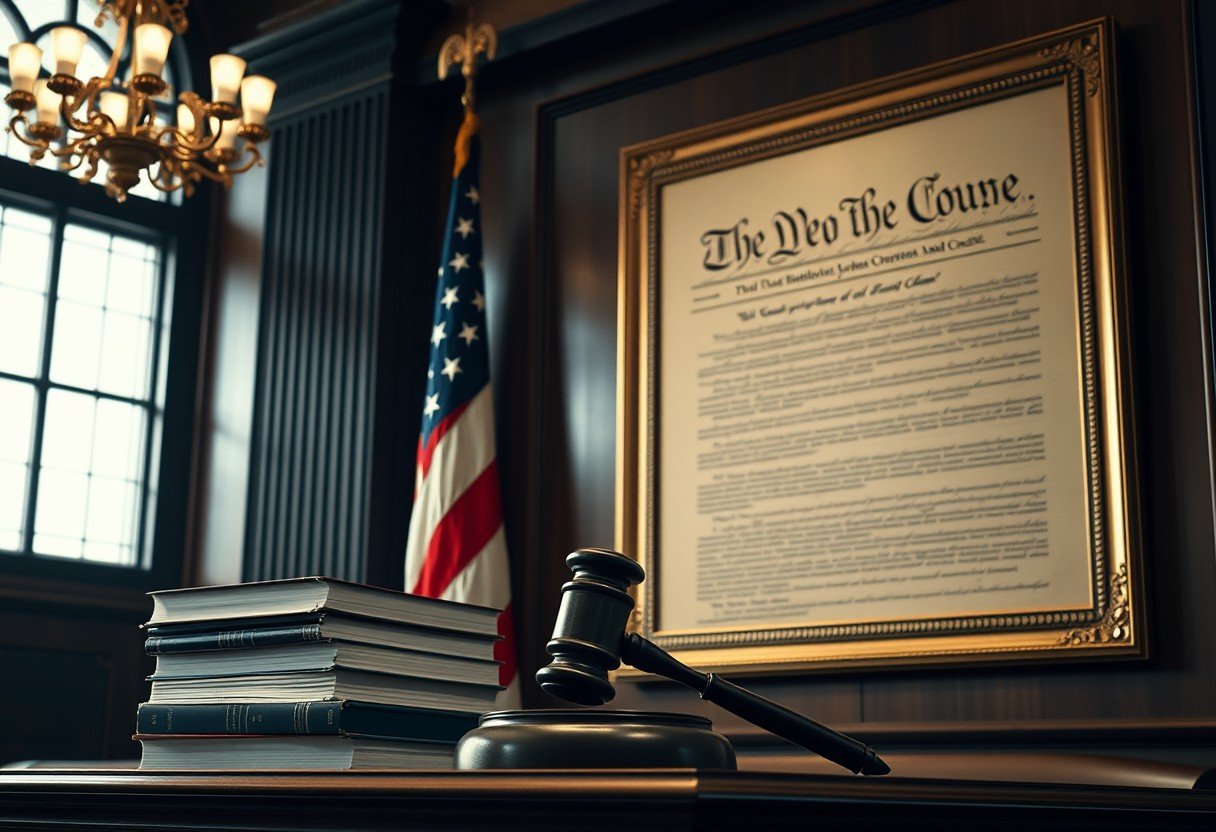The Supremacy Clause, found in Article VI of the U.S. Constitution, is a core principle of American government. It establishes that federal laws and the Constitution are the “supreme law of the land,” taking priority over any conflicting state laws. This simple rule is the bedrock of federalism, creating a necessary hierarchy that allows a unified nation to function while still preserving states’ powers. Understanding this clause is key to seeing how power is balanced in the United States.
What is the Supremacy Clause?
At its heart, the Supremacy Clause is a conflict-resolution tool. It declares that the Constitution, federal laws made under it, and treaties are the highest form of law in the country. This means if a state law clashes with a federal law, the federal law wins.
The founders included this clause to fix a major problem from the Articles of Confederation, where states often ignored national laws, creating chaos and disunity. The Supremacy Clause ensures a cohesive legal system across all states. It prevents a patchwork of conflicting rules that would make national governance impossible.
This principle doesn’t erase state laws. States have broad powers to legislate on local issues. However, it sets clear boundaries, ensuring that states operate within the framework established by the federal government for matters of national importance.
Understanding Federalism in American Government
Federalism is the system that divides power between a central, national government and regional state governments. Think of it as a partnership where both levels of government have their own responsibilities. This structure is unique because it prevents power from being concentrated in one place.
This division of power allows states to act as “laboratories of democracy.” They can experiment with new policies on issues like education, healthcare, or transportation. If a policy is successful, other states or even the federal government can adopt it. This fosters innovation and allows laws to be tailored to the specific needs of different communities.
Federalism creates a balance that protects national interests while respecting local differences. It ensures that while the country is united under one federal law, states can still govern themselves in a way that reflects the values of their citizens.
How the Preemption Doctrine Works
The Supremacy Clause gives rise to a legal principle known as the “preemption doctrine.” This doctrine is the practical application of the clause. It means that federal law can preempt, or overrule, state law when there is a direct conflict.
There are a few ways preemption can happen:
- Express Preemption: This is when a federal law explicitly states that it is meant to override any state laws on the same subject.
- Conflict Preemption: This occurs when it’s impossible to follow both a state law and a federal law at the same time.
- Field Preemption: This applies when the federal government has created such a comprehensive set of regulations in a certain area that it’s clear they intended to “occupy the field,” leaving no room for state laws.
For example, federal aviation laws are so extensive that states are generally preempted from making their own rules about airline safety. The preemption doctrine is how courts resolve disputes between state and federal authority.
The Supreme Court’s Role in Defining Federal Power
The Supreme Court is the ultimate referee in the federalism debate. For over 200 years, its rulings have shaped the balance of power between the states and the federal government by interpreting the Supremacy Clause.
Landmark cases have consistently reinforced federal authority. In McCulloch v. Maryland (1819), the Court ruled that states could not tax a federal bank, establishing that federal institutions were immune from state interference. This decision solidified the idea that federal law is superior.
More recently, in Arizona v. United States (2012), the Court struck down parts of an Arizona immigration law. It found that the federal government has broad authority over immigration, and the state’s laws interfered with that federal power. These cases show how judicial interpretation keeps the Supremacy Clause relevant in modern times.
The table below highlights the key principles from these landmark cases.
| Supreme Court Case | Year | Key Principle Established |
|---|---|---|
| McCulloch v. Maryland | 1819 | Affirmed federal supremacy and established that states cannot impede valid federal actions. |
| Gibbons v. Ogden | 1824 | Broadly interpreted the federal government’s power to regulate interstate commerce. |
| Arizona v. United States | 2012 | Reinforced that federal law preempts state law in areas of exclusive federal authority, like immigration. |
State Sovereignty versus Federal Authority
The Supremacy Clause creates a constant tension between state sovereignty and federal authority. While it establishes federal law as supreme, it does not eliminate the power of states. The 10th Amendment reserves powers not delegated to the federal government to the states.
This creates a dynamic balance. States can and do push back against what they see as federal overreach, leading to legal and political battles. These disputes often center on issues where state and federal priorities differ, such as environmental regulations, healthcare mandates, or civil rights.
This ongoing dialogue is a healthy and essential part of the American federalist system. It forces both levels of government to justify their actions and ensures that power remains distributed, preventing any single entity from becoming too dominant. The Supremacy Clause provides the rulebook for how these conflicts are ultimately resolved.
Why the Supremacy Clause Still Matters Today
The Supremacy Clause is not just a historical concept; it is highly relevant in contemporary debates. Many of today’s most pressing political issues involve conflicts between state and federal laws.
Consider the legalization of marijuana. While many states have legalized it for medical or recreational use, it remains illegal under federal law. This creates legal confusion and highlights the ongoing tension that the Supremacy Clause is meant to manage. Similarly, debates over immigration enforcement, climate change policies, and gun control often pit state laws against federal regulations.
These modern challenges show that the Supremacy Clause continues to be the central mechanism for navigating the complexities of federalism. It ensures that despite disagreements, there is a clear legal framework for determining which law prevails, maintaining order and unity across the nation.
Frequently Asked Questions about the Supremacy Clause
What happens if a state law conflicts with the U.S. Constitution?
If a state law conflicts with the U.S. Constitution, the state law is void. The Supremacy Clause makes the Constitution the absolute supreme law of the land, and no law, federal or state, can violate it.
Does the Supremacy Clause mean federal law is always better than state law?
Not necessarily. It simply establishes a legal hierarchy. States are free to create their own laws, and many provide greater protections or address local issues more effectively than federal law. The clause only comes into play when there is a direct conflict.
Can states challenge a federal law they believe is unconstitutional?
Yes, states have the right to challenge federal laws in court. If a court agrees that a federal law exceeds the powers granted to the federal government by the Constitution, it can be struck down.
How does the Supremacy Clause relate to international treaties?
The Supremacy Clause states that treaties made under the authority of the United States are also the supreme law of the land. This means that a ratified treaty has the same legal weight as a federal law and can override conflicting state laws.
What is the difference between federalism and the Supremacy Clause?
Federalism is the overall system of dividing power between national and state governments. The Supremacy Clause is a specific rule within that system that clarifies which law takes precedence when the two levels of government are in conflict.









Leave a Comment